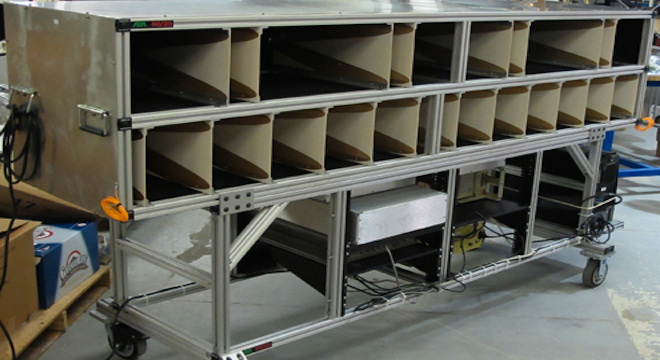Forget x-ray vision. MIT scientists have developed something better: A new radar array that can “see” movement as slight as a person breathing through solid concrete walls up to eight inches thick.
“We have found that if you are standing still behind the 8″ solid concrete wall we can see you as red blob on about half of the frames,” of the radar display screen, wrote the device’s lead developer, Gregory Charvat, in an email to TPM, “This is because the body moves slowly when breathing and standing.”
Charvat and his colleagues at MIT’s Lincoln Laboratory, a federally-funded national security research center, demonstrated the incredible result on a new phased-array radar system that they built, consisting of 13 conventional radar transmitters arranged in a row and eight receivers below them, coupled with amplifiers, a crystal filter and coaxial cable, all of which is assembled into an 8-ft. long device that can fit into a vehicle for mobility.
The transmitters, which can be mounted up to 60 ft. away from the target wall, send out 44 individual, alternating S-band wave beams toward the wall in continuous succession. These are shorter wavelength radar waves akin to the waves of a wireless internet connection.
MIT could have used longer wavelength radar to achieve more accurate results, but it would have necessitated a much larger apparatus that wouldn’t be convenient for the device’s target field of application: the urban battlefield.
“This is meant for the urban war fighter … those situations where it’s very stressful and it’d be great to know what’s behind that wall,” he said in a press release on the new device.
But only about 0.6 percent of the total radiation emitted towards the concrete wall gets through the material, bounces off the figures moving on the other side, and passes back through the wall to be picked up by the receivers, again losing 99.4 percent of it’s strength. That’s what the amplifiers and the crystal filter are for.
The amplifiers increase the strength of the radar beams and the crystal filter distinguishes between the analog frequency of the incoming radar waves, allowing the device’s operators to effectively “subtract” the radar image of the concrete wall, which would otherwise appear as the brightest element in the radar display screen, washing out everything else, including the movement on the other side. It’s this filtration method that gives Charvat and company’s device the edge of other radar arrays.
“I developed the idea of using a crystal filter as a range-gate while I was in grad school,” Charvat wrote to TPM in an email. “I’ve never seen anyone use a crystal filter in this way, they are typically only used for old fashion radio communications equipment.”
Charvat noted that competing see-through technology, such as forward-looking infrared (FLIR), “can’t see through concrete walls.”
Other projects that have claimed to be able to see through walls, such as ultra-wide band radar wave “flashlights” and x-ray handheld devices such as the LEXID imager aren’t nearly as capable.
“We have sufficient resolution to count individual humans, we do a very good job at rejecting stationary clutter by using coherent change detection, we plot the imagery in real-time at the video-like frame-rate of 11 Hz, and our system operates at safe stand-off distance from the wall,” said Charvat to TPM.
Indeed, Charvat and his team were recognized for their work, winning best paper at the 2010 Tri-Services Radar Symposium. But the team only recently widely publicized their findings in a YouTube video demibstrated posted on MIT’s News account.
Now, his goal is to improve the imaging on the radar display itself. While moving objects currently appear as amorphous blobs, his team is working on an algorithm that will display the objects as more defined shapes. Charvat also notes that the radar only currently shows the perspective of top-down, even when pointed sideways at the wall. Still, he thinks that the practical applications of the device aren’t that far off.
“We could make a rapid prototype for field use in 12 months or less,” Charvat wrote to TPM.
As for what inspired him to undertake the project in the first place, Charvat told TPM he started “by sketching out a variety of linear FM radar block diagrams with crystal filters, drinking way too much coffee, and listening to Eric Clapton’s Crossroads album.”









